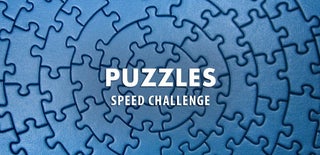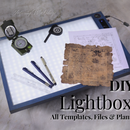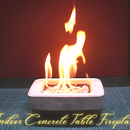Introduction: Concrete Cube Puzzle
Hello Instructable team and my dear viewers ... Today I'm going to share my project and also my failures in making this project...in this project, learnt many things and new techniques for this kind of project in the upcoming steps...
For this Puzzle Contest, firstly decided to make something else but finally, chose this project because I thought that this will be a 2 in one puzzle and also a good opportunity for me to learn new skills ...
In this project, made 1 perfect 2*2cm cube out of m-seal and used that for the reference cube for the whole process..I first tried to make the cubes with cement+sand mixture but after 3 failed attempts I used only Cement with some white cement.. and that worked..Though I realized some more mistakes of mine later... I will discuss those mistakes in the folloing steps...
I made 64 individual cubes and then I made them into puzzle pieces... and also used some printouts for the outsides...
Step 1: Supplies We Need...
For making this project... we don't need any professional tools and supplies.... just some basic and common to found items are enough...
We need-
- Cement
- White Cement
- M-seal
- scale
- Sand Paper
- Cardboard strip / hard plastic strip
- Glue gun
- Printer
Step 2: Making the Perfect Cube
I started this project by simply creating a cardboard box....and filling it with some epoxy clay or m-seal...After the clay hardened I demoed the rough cube... At this step, the size of the cube was 2.4*2.4 cm...
I used 80 grit sandpaper to firstly reduce the overall size of the cube to approx 2.1 cm * 2.1 cm * 2.1 cm cube...
Then with finer grits of sandpaper (100, 180, 220, 320, 400, and above) I shaped the cube to its final size ... I used a right angle tool to measure the sides to keep them at 90 degrees... Then I did the rough polish for making it look better...
I could make the cube more precise but that was not so important for the upcoming steps...
Step 3: Making the Cardboard Moulds
Firstly I tried to make the moulds with plastic strips but as I didn't have much of them and thus I had to use those moulds several times I dropped that idea and instead I took a better way of doing the work... I firstly cut many strips of medium-thick cardboard... then I formed them into cube-shaped moulds bu just using the reference cube I made earlier...
I wrapped the cardboard strips around the cube and used my glue gun to form the mould... Just by repeating this boring and time-consuming step over and over, I made 64 moulds in total... after all these mould sides are made I stuck them on another piece of cardboard and completed the mould...
***use some tape on the cardboard before making the mould ... otherwise, the cement will be disturbed by the cardboard as the cardboard will soak water from the cement and will make the cube sides fragile(I made this mistake..don't repeat that)
Step 4: Mixing the Cement
For the Concrete part, I firstly used cement and sand in 2:1 ratio but soon I realized that the sand in the concrete will make the cubes almost impossible to shape with sandpaper..(As both have sand in and on them)...
So I later used only cement and a little bit of white cement mixture and that worked just fine for me... Note one thing that using sand in any casting will reduce the opportunity of shaping the casting...
Step 5: Filling the Moulds...
I marked the top level of the 2 cm cube while making the moulds ...
So using that marking I filled the moulds and also filled a little bit extra as the cement can shrink a little bit after the water dries...so without taking any risk I simply filled those 64 individual moulds..
In this process make sure to heavily shake the mould to release any trapped bubbles as those will weaken the cubes later and creat bubbles in the casting...
** while mixing the cement don't add too much water... use a little bit of water at a time and fill the moulds with moreover less watery cement...This will help to make the casting faster...
Step 6: Let It Set...
After the moulds are filled and the bubbles are taken out leave the castings for at least 36 hours ....more will be fine.. This step is very necessary for casting anything useful out of cement...
don't disturb the cement while it is curing.....
Step 7: Demoulding the Cubes
After the cement is set properly.. submerge the cubes with their moulds into the water and let them some water for at least 30 minutes...
After the moulds are wet properly.. just peel off the cover and take out the cubes...
if you had used tape on the cardboard, then the cubes will have crisp and sharp edges and surfaces... But as I stated earlier I made that mistake and some of the cubes got disturbed by the cardboard...and I had to fix them later... so don't do what I did...
Now as you de-moulded the cubes its time to sand down the edges to final length...
Step 8: Sanding the Cubes...
Now after removing the moulds I started to sand down the edges to final size...
This work took me almost 5 hours .. as I do all these work manually I had to work very hard every time...
Use 100 grit sandpaper for best result and let them dry for some time...
Step 9: Joining the Cubes...
In this step use some more freshly mixed cement and join the cube into puzzle pieces as I showed in the picture... for the job I used the Tinkercad software for making the 3d model beforehand...
I just followed what I made in the software... and used cement to fix the damaged cubes a little bit...
**as I was doing all of these work manually the cubes and the puzzle pieces came out faulty...They were not aligned perfectly ..but they fit perfectly..... A well-made mould(Probably with 3d printer) will be more preferable for these king of precise jobs...as I don't have them... I do my work manually...
Step 10: Do a Test Fit
Do a test fit... before sticking the outer designed...
Step 11: Print the Templates...
Print the templates...on an A4 sheet of hard paper...
link - https://drive.google.com/drive/folders/11CI5clbrgXu-e0ZSOPnkcq60QsUK4Owh?usp=sharing
Then simply just cut the templates along the lines and get ready for the final step...
Step 12: Stick the Designs...
After the cube is assembled perfectly and the 6 sides are dry... stick the designs with some craft glue..
Glue one side at a time....take proper time for each side and let the sides dry well...
You may use your own templates or designs if you want... You may also decorate the cube with whatever you want..the main thing is to make it more like an actual puzzle...
Step 13: We Are Done...
After all these madness with cement and concrete, our puzzle is finally done and ready to share with others...
Notice one thing... as the whole process is done manually and with zero power tools, the final piece is not perfect as 3d printers or any other similar methods... I think this is a good opportunity to learn some new skills and making an interesting puzzle just with a few items...
For more details and full video tutorial you may also go to my youtube channel where I will upload the whole process from start to end with more details...(as soon as I can finish the editing...)
Thanks for having a look at this project... Pls vote this Instructable and also subscribe to my channel for more upcoming content...
** For any other step details and help ..Feel free to comment down...with your thoughts, questions, and suggestions...
Also if you want to see more of my creations.. subscribe to my youtube channel "Infinity workshop".
**Follow Infinity Workshop
Facebook: https://www.facebook.com/InfinityWork... Twitter: https://www.facebook.com/InfinityWork... Pinterest: https://www.facebook.com/InfinityWork... Instagram : https://www.facebook.com/InfinityWork... Instructables: https://www.facebook.com/InfinityWork...
-----------------------------------------
## Consider supporting my channel by giving like, share, comment & Subscribing #Infinity_Workshop Thanks for supporting...

Second Prize in the
Puzzles Speed Challenge













